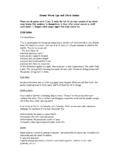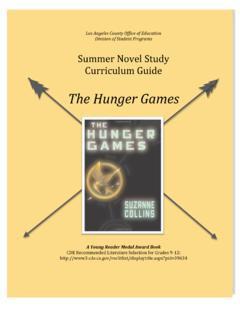Transcription of GCSE Drama GCSE Drama Preparing to teach
1 gcse . Drama . Preparing to teach Teaching and Learning Resources 8261. Summer 2016. Version 1. Contents The roles and responsibilities of theatre makers p 4. Stage positioning and configuration starter games p 5. Strategies for exploring the set plays p 8. Ideas for teaching the devised component p 12. z The roles and responsibilities of theatre makers Knowledge and understanding should cover: the activities each may undertake on a day-to-day basis the aspect(s) of the rehearsal/performance process each is accountable for (their contribution to the whole production being a success). Theatre Maker Role and responsibilities Playwright This is the name given to the person who writes the play. Performer A performer is an actor or entertainer who realises a role or performance in front of an audience. Understudy An actor who studies another's role so that they can take over when needed. Lighting designer The lighting designer is responsible for designing the lighting states and, if required, special lighting effects for a performance.
2 The final design will result in a lighting plot which is a list of the lighting states and their cues. Sound designer The sound designer is responsible for designing the sound required for a performance. This may include underscoring, intro and outro music as well as specific effects. The final design will result in a sound plot which is a list of the sounds required and their cues. Set designer The set designer is responsible for the design of the set for a performance. They will work closely with the director and other designers so that there is unity between all the designs and the needs of the performance. Costume designer The person who designs the costumes for a performance. The costume department of a theatre is often called the wardrobe. Puppet designer The person who designs the puppets for a performance. Technician A person who works backstage either setting up technical equipment such as microphones or rigging lights before a production or operating technical equipment during a performance.
3 Director A director is in charge of the artistic elements of a production. A director will often have the initial creative idea ( concept') for a production, will work with the actors in rehearsal, and will collaborate with designers and the technical team to realise this idea in performance. Stage manager The Stage Manager is in charge of all aspects of backstage, including the backstage crew. They will oversee everything that happens backstage before, during and after a performance. During the rehearsal period, the Stage Manager and their team will make sure that all props are found or made, scene changes are rehearsed and smooth, and all other aspects of backstage are prepared. They are also in charge of the rehearsal schedule. Theatre manager This is the person who is responsible for and manages the front-of- house team who deal with the audience during the production (for example, the box office manager, ushers and similar staff). 4. Stage positioning & configuration starter games The Placement Game The aim of the game is to encourage students to use the stage abbreviations and also to become familiar with the different stage configurations Either in groups or as a class define a stage configuration use the students, chairs or tape to mark this out.
4 Only the students who correctly identify the configuration are allowed into the performance space. Once in the space either the teacher or a student names someone in the space and calls out a specific stage position which they have to move to. This game does become more difficult when, for example, the traverse or thrust configurations are used. Link Up games GAME 1: The aim with this game is for students to gain an understanding of job roles and responsibilities. Prepare 2 sets of cards 1 set identifies the role The other set identifies the responsibilities Hand the cards out and ask the students to pair the roles and responsibilities Check the correct identification as a class GAME 2: The aim with this game is to familiarise students with stage positions and stage configurations. Prepare 3 sets of cards 1 set has a picture or drawing of the configuration of a performance space on this is marked a stage position 5. the 2nd set has the name of the configuration the 3rd set identifies the stage position Hand the cards out and ask the students to link the name of the configuration and the correct stage position to the performance space Check the correct identifications as a class GAME3: The aim with this game is for students to gain an understanding of job roles and responsibilities (a good one for visual learners).
5 Prepare 2 sets of cards 1 set has a picture of , for example, a costume, set, lighting grid, props table The other set identifies the job roles and responsibilities that match the pictures on the first set of cards Hand the cards out and ask the students to pair the picture to the correct role and responsibility Check the correct identifications as a class The Actor's On the Stage This is a Drama take on the farmer's in his den the aim is to reinforce an awareness of all the elements and personnel that work together to create a performance. Have fun with your own combinations of what the actor wants; you may find it useful to issue the cards from the Pair Up Game. Create a circle with the actor' in the middle The actor calls out what he/she wants; The actor wants a costume, lighting, a prompt, a prop etc. Develop the game further by throwing another aspect in such as a particular stage configuration Throw a sound effect bomb by calling out SFX (imagined or recorded) which everyone in the space must react to Throw a lighting bomb by calling out LX (imagined or recorded) which everyone in the space must react to TIP you can develop/ adapt this game by changing the actor to another specific job role 6.
6 The Who Am I Game This is a take on a very well-known party game. The aim is to foster understanding of the different job roles and responsibilities in the theatre. A card or sticker is put on each student's back with the name or title of a specific job role identified. The students have to correctly identify what their title or job role is by asking questions of other students as they move around the room. When they have guessed correctly they must move to the side of the room. 7. Strategies for exploring the set plays The Crucible : Ways into the text performing Improvise a scene where a trial is being held to judge an innocent man of witchcraft. Allocate roles such as judge, jury, accuser, defendant. Excuses, excuses, create a scene where a group of friends have been discovered doing something they know to be wrong but one person is denying having taken part. Prove it, working in pairs or small groups one person has to prove their innocence of something they have been accused of Mime a scene where one student is serving another a meal, the object is to create tension through non-verbal communication.
7 The gossip game where the aim is to try and top the revelations from other students in the group. The Crucible : Ways into the text design Choose a section of the play which could be set using simple furniture and props, the Proctor's kitchen, the courtroom, the cell in Salem. Use aprons, headscarves, long skirts, jerkins and hats to create an impression of costume. Sound effects of softly dripping water and rustling noises create an eerie and chilling effect for a jail scene especially if the lighting is at a low intensity. Simple make-up can be used to create contrasts between characters, ruddy cheeks for farmers, lines to denote age, scars and bruises for those in jail. Consider using puppets in the court scene to illustrate how the girls are being manipulated. Blood Brothers : Ways into the text performing Play aged 7 nearly 8 games such as cops and robbers, Simon says, tig, zip-zap- boing or mime playing marbles, hopscotch or ball games . Improvise an enduring friendship ritual to include specific actions and a solemn oath.
8 Superstitions and consequences; speak the superstition and act out the supposed consequence. Status games such as master and servant, rich and poor, parent and child. Improvise a scene which a narrator has to start and finish in such a way as to create a sense of foreboding. Show an online guide to creating a Liverpool accent and encourage your students to speak lines from the text using this accent. 8. Blood Brothers : Ways into the text design Choose a section of the play which could be set using simple furniture and props, Mrs Lyons's living room, the classroom, Mrs Johnstone's kitchen. Find pieces of clothing which will help to establish a character, a long dark coat for the Narrator, shorts and baggy jumpers for the children, an apron for Mrs J. Use sound for the transitions between moments in the play such as dance music, the ring of a bus as it moves off, a school bell, countryside effects and support these with appropriate lighting effects. Research into what was fashionable in terms of make-up and hair styles for the chosen period and consider effective ways of showing how the characters age during the play.
9 The 39 Steps : Ways into the text performing Quick fire characterisation; played as a game in groups or as a whole class this is great fun. Use sundry items of costume and/or props to change character both physically and vocally. Improvise scenarios which are performed in a melodramatic style such as sinister spies, suspicious travelling companions. Focus on pace and characterisation. Status and class are an important in this play so work on how this is shown in the Milkman and Hannay. Experiment with accents and voices in general, there is a variety of them to play around with from RP to Mr. Memory's thankoo by way of Scotland. Develop the previous work physically to demonstrate character realisation. The 39 Steps : Ways into the text design Choose a section of the play which could be set using simple furniture and props, Hannay's flat, the train, crofter's cottage, hotel reception. A selection of hats, coats and basic props would be useful to allow students to experiment with quick changes and character transitions.
10 Plenty of opportunities here for really creative lighting and sound effects such as the train, interiors and exteriors, but make sure they suit the action and the period. Research into what was fashionable in terms of make-up and hair styles for the chosen period; a pencilled or stick on moustache for Hannay is a must. Consider using puppets for comic opportunities, creating a moment outside Hannay's flat where a puppet is seen standing under a street light or even for the whole of the Forth Bridge scene. Hansel and Gretel : Ways into the text performing This would make an excellent TIE piece, so think primary school/ family audience and a fast paced approach with confident direct address and lively storytelling. To establish the style improvise panto scenes or simple folk tales in a heightened and exaggerated manner. Use physical theatre to create living scenery. 9. Become the farmyard animals, developing from simple mimed actions to noisy interacting, feeding, gossiping animals who own the space.















